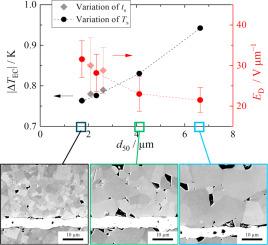Lead-free (Ba,Sr)(Sn,Ti)O3 multilayer ceramic components for electrocaloric application
IF 2.8
Q1 MATERIALS SCIENCE, CERAMICS
引用次数: 0
Abstract
In this paper, we report on multilayer ceramic components based on (BSSnT) with addition or modification for electrocaloric (EC) cooling applications. The influence of sintering parameters on grain size, dielectric and EC properties are investigated. In components with addition we could increase grain size from 0.4 µm to 4.6 µm by adapting sintering parameters. With increasing grain size dielectric strength is reduced, thus limiting EC properties. In BSSnT components modified with , grain size was increased from 1.7 µm to 6.6 µm, resulting in an increase of EC temperature change from 0.76 K to 0.94 K under an electric field change of 14 V µm−1. Simultaneously, dielectric strength decreases from 31.6 V µm−1 to 21.5 V µm−1. Therefore, the optimal grain size represents a compromise between a moderate EC effect and a moderate dielectric strength, since both properties show an opposite dependence on grain size.

无铅(Ba,Sr)(Sn,Ti)O3多层陶瓷元件的电热应用
本文报道了一种以Ba0.82Sr0.18Sn0.065Ti0.935O3 (BSSnT)为基础,添加MgO或Ca改性的用于电热(EC)冷却的多层陶瓷元件。研究了烧结参数对晶粒尺寸、介电性能和电导率的影响。在添加MgO的组分中,通过调整烧结参数可以将晶粒尺寸从0.4µm增加到4.6µm。随着晶粒尺寸的增大,介电强度降低,从而限制了EC性能。在电场变化为14 Vµm−1时,Ca修饰的BSSnT组分晶粒尺寸从1.7µm增加到6.6µm, EC温度变化从0.76 K增加到0.94 K。同时,介质强度从31.6 Vµm−1降低到21.5 Vµm−1。因此,最佳晶粒尺寸代表了中等EC效应和中等介电强度之间的折衷,因为这两种性能对晶粒尺寸的依赖性相反。
本文章由计算机程序翻译,如有差异,请以英文原文为准。
求助全文
约1分钟内获得全文
求助全文
来源期刊

Open Ceramics
Materials Science-Materials Chemistry
CiteScore
4.20
自引率
0.00%
发文量
102
审稿时长
67 days
 求助内容:
求助内容: 应助结果提醒方式:
应助结果提醒方式:


